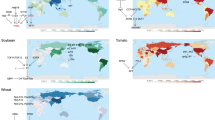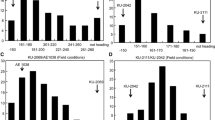Abstract
Studies of flowering in sesame (Sesamum indicum L.) under different photoperiods revealed that cultivars Glauca, Venezuela-52 and Oro were short day strains while a fourth cultivar, Aceitera, proved to be day length neutral. Sensitivity to varying photoperiods, then, does not seem to be a universal characteristic of all sesame cultivars. Also, no correlation was found between photoperiodic class and latitude of origin in the cultivars studied.
Inheritance studies involved crosses between the day neutral cultivar and two of the short day cultivars. In all cases, the F2 populations demonstrated continuous variation. Most of the F2 variability was of genetic origin and heritability values ranged from 86 to 96%. Additionally, transgressive segregation was observed for both early and late flowering. It is proposed that a minimum of three loci are involved in the inheritance of photoperiodic response in the sesame cultivars studied.
Similar content being viewed by others
Literature cited
Fu, Ka-Shui. Studies on the photostage of sesame. (In Chinese with English summary). Acta Agr. Sinica 10(3): 177–188. 1959.
Kurnik, E. The significance of the photoperiod in plant acclimatization. Kiserl. Kozl.50:57–59. 1956.
Matsuoka, K., N. Taniguchi, M. Kawakami and K. Ito. Studies on the sesame varieties. (Part 12) Classification of sesame varieties with reference to days to flowering and maturity, and percentage of oil content. (In Japanese with English summary). Shikoku Agri. Expt. Sta. Bull.5: 27–46. 1961.
Nohara, S. Genetical studies onSesamum indicum L. J. Coll. Agric. Imp. Univ. Tokyo12(2): 227–386. 1933.
Rhind, D. A note on photoperiodism in sesamum. Indian J. Agric. Sci. 5: 729–736. 1935.
Rhind, D. and B. Thein. The classification of Burmese sesamums(Sesamum orientale L.). Indian J. Agric. Sci.3(3): 478–495. 1933.
Sen, N. K. and S. K. Pain. Photoperiodic effect on sesamum in relation to the variations of the environmental factors of the different seasons. Proc. Nat. Inst. Sci. India14(9): 407–420. 1948.
Sen Gupta, J. C. and N. K. Sen. Photoperiodic effect onSesamum indicum Linn. Sci. and Cult.13(5): 203–204. 1947.
Smilde, K. W. The influence of some environmental factors on growth and development ofSesamum indicum L. Medel. Landbouw-hogesch. Wageningen60(5): 1–70. 1960.
Author information
Authors and Affiliations
Additional information
Contribution from the Department of Plant Sciences, University of California, Riverside, California.
Rights and permissions
About this article
Cite this article
Kotecha, AK., Yermanos, D.M. & Shropshire, F.M. Flowering in cultivars of sesame (Sesamum indicum) Differing in photoperiodic sensitivity. Econ Bot 29, 185–191 (1975). https://doi.org/10.1007/BF02863318
Received:
Issue Date:
DOI: https://doi.org/10.1007/BF02863318




